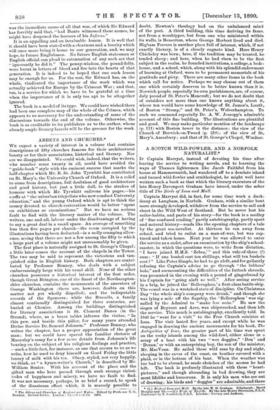ABBEYS AND CHURCHES.*
WE expect a variety of interest in a volume that contains descriptions of fifty churches famous for their architectural beauty or for their associations, historical and literary. Nor are we disappointed. We could wish, indeed, that the writers, who number some twenty in all, could have avoided the " guide-book " style with the eminent success that marks the half-chapter which Mr. R. St. John Tyrwhitt has contributed on St. Mary's, the University Church of Oxford. It is a relief to come from descriptions, full doubtless of good architecture and good history, but just a little dull, to the strokes of humour with which Mr. Tyrwhitt enlivens his pages,—his scoffs at " the suburban tricyclists who now conduct University education," and the young Oxford which is apt to think the money devoted to church-restoration would be better " spent on exhibitions or examinations." But we have no serious fault to find with the literary matter of the volume. The writers, one and all, labour under the disadvantage of having to say a great deal in a small space. An average of something less than five pages per church—the room occupied by the illustrations having been deducted—is a sadly cramping allow- ance, seeing that there are not a few among the fifty to which a large part of a volume might not unreasonably be given.
The first place is naturally assigned to St. George's Chapel ; a little later comes the account of the chapels in the Tower. The two may be said to represent the victorious and van- quished sides in English history. Both chapters are contri- buted by Professor Bonney, who deals with a subject embarrassingly large with his usual skill. None of the other churches possesses a historical interest of the first order, though Great Brington, one of the finest of the Northampton- shire churches, contains the monuments of the ancestors of George Washington (there are, however, doubts on this matter not yet wholly dispelled), and the indisputable records of the Spencers ; while the Russells, a family almost continually distinguished for three centuries, are buried at Chenies. Among the buildings distinguished for literary associations is St. Clement Danes (in the Strand), where, as a brass tablet informs the visitor, " In this pew, and beside this pillar, for many years attended Divine Service Dr. Samuel Johnson." Professor Bonney, who writes the chapter, has a proper appreciation of the great man ; but we could have spared the familiar rhetoric of Macaulay's essay for a few more details from Johnson's life bearing on the subject of his religious feelings and practice, —such a little fact, for instance, as one that occurs to us as we write, how he used to deny himself on Good Friday the little luxury of milk with his tea. Olney, styled, not very happily, we think, as " a hymn-writer's Church," is described by Mr. William Senior. With his account of the place and the gifted man who here passed through such strange vicissi- tudes of happiness and misery, we have no fault to find. It was not necessary, perhaps, in so brief a record, to speak of the disastrous effect which, it is scarcely possible to
• The Abbeys and Cherchee of Znyland and Wales. Edited by Professor T. G. Bonney. Second Series. London : Cassal and Co 1890.
doubt, Newton's theology had on the unbalanced mind of the poet. A third building, this time deriving its fame, not from a worshipper, but from one who ministered within- its walls, is Bemerton, where George Herbert lived and died- Higham Ferrers is another place full of interest, which, if not exactly literary, is of a closely cognate kind. Here Henry Chicheley was born ; here, if the tradition may be trusted, he tended sheep ; and here, when he had risen to be the first subject in the realm, he founded institutions, a college, a bede- house, and a school, which, along with his splendid endowment of learning at Oxford, were to be permanent memorials of his
and piety. There are many other items in the book which call for notice. Perhaps we may choose out of them one which certainly deserves to be better known than it is Norwich people, especially its own parishioners, are, of course, duly proud of St. Peter's Mancroft ; but we do not doubt that of outsiders not more than one knows anything about it,. where ten would have some knowledge of St. James's, Loutb,. of Boston " Stump," and St. Peter's, Wolverhampton. To such we commend especially Dr. A. W. Jessopp's admirable account of this fine building. The illustrations are plentiful and good. We may make particular mention of the landscape (p. 111) with Boston tower in the distance ; the view of the Church of Berwick-on-Tweed (p. 210); of the view of St.. Mary's, Amesbury ; and that of St. George's Chapel, Windsor.










































 Previous page
Previous page